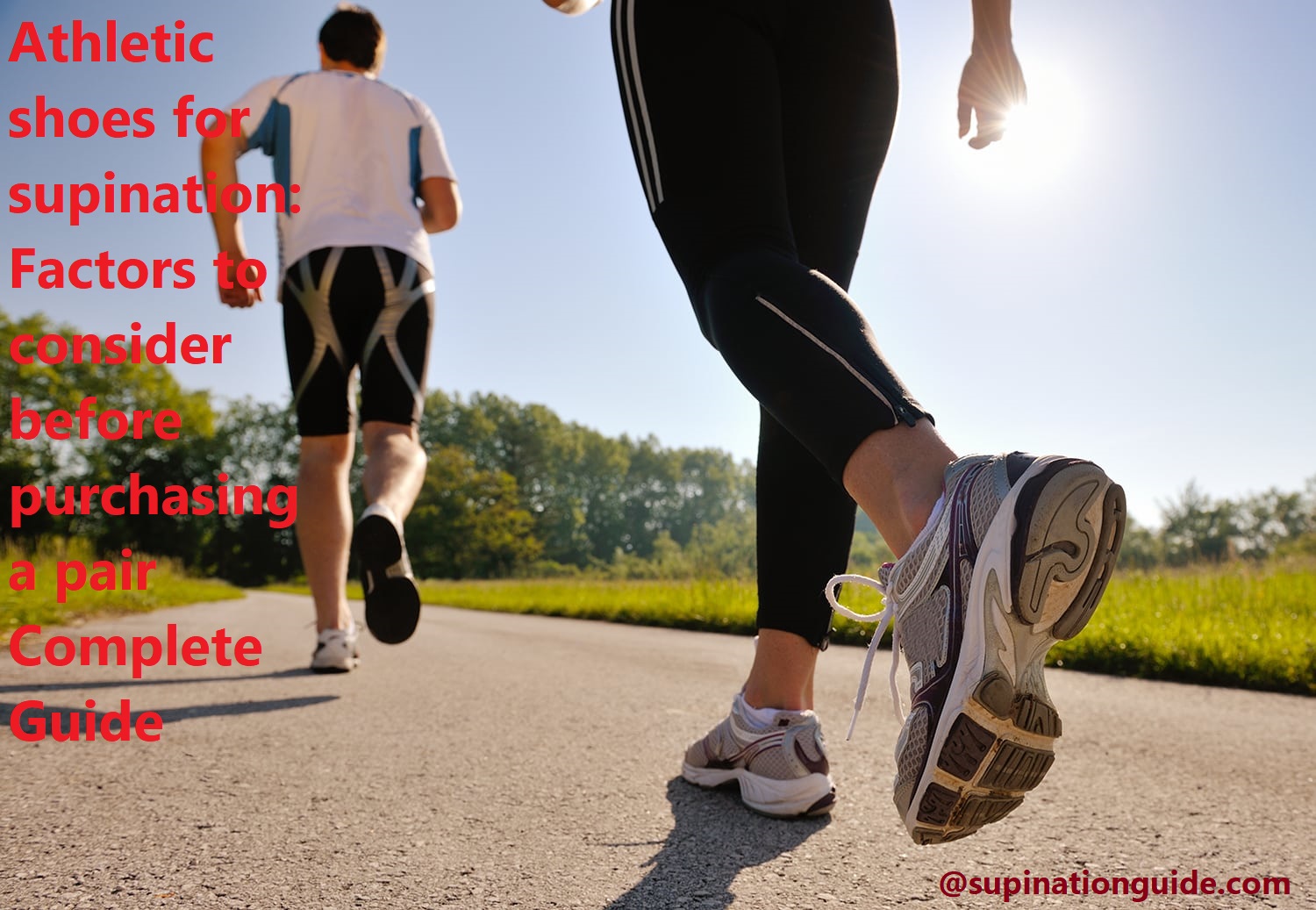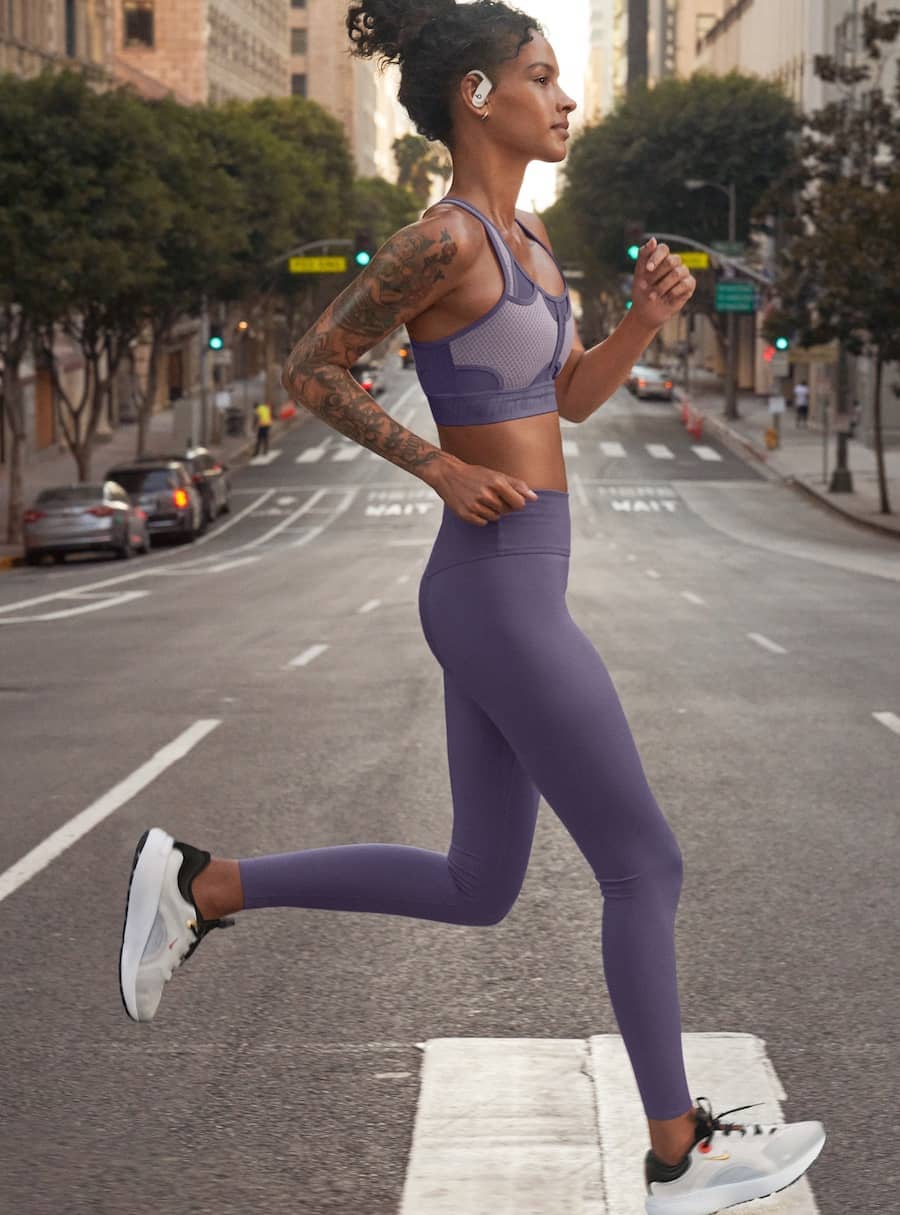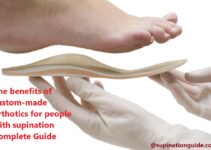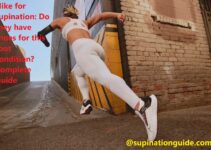Are you a supinator in search of the perfect pair of athletic shoes? If yes, then this guide is just for you!
Here, we have enumerated the factors that will help you find the best shoes for your supination. So, let us delve into it and find out what makes them so special.
When choosing a supportive athletic shoe, it is important to take into account the condition of the feet and legs. For those with a condition called supination, the right fit of shoe is essential for pain-free activity. This guide will explain the different types of athletic shoes available for supination and help you select the best option based on your lifestyle and budget.
Supination is a condition where there is uneven distribution of weight across the foot when walking or running. People with this condition may experience pain in their feet and lower legs due to an excessive inward rolling motion at ankle joints as weight is shifted from one foot to another during motion. To counter this action, special shoes designed for supination provide adequate cushioning to absorb shock and lessen strain on affected areas.
The types of shoes that are available for supination vary with both price point and features offered. As such, it is important for individuals seeking relief from their supination symptoms to do research and make an informed decision when selecting an athletic shoe that provides support while being suitable for their particular circumstances.
Understanding Supination
Supination, also known as under-pronation, is a type of gait abnormality where the foot rolls outward when walking or running. This motion can cause excessive wear on the outside edges of your shoes and increases your risk for developing certain conditions such as Shin Splints and Plantar Fasciitis. It is important to find shoes that are designed to minimize this motion and provide adequate cushioning and arch support in order to protect you from injury.
When selecting athletic shoes specifically designed for supination, it is important to consider several factors including size, shoe type, heel-stiffness, cushioning and arch support. For an accurate fit, make sure you measure your feet with a Brannock Device® at an athletic shoe store before purchasing a pair of shoes. The length, width and arch height should all be taken into account when selecting your new shoes.
The type of shoe you select should also be based on the types of activities you will use them for. Running or Cross-training shoes are often best for runners who supinate because they provide added stability; however a good walking shoe might be more appropriate for daily activities if long-distance running is not a major concern. When shopping for athletic shoes specifically designed for supination it is also important to check the stiffness level of the heel counter (the part that encircles the back of your heel). Heel counters with low stiffness are less supportive and often do not provide enough protection from excessive pronation while running or walking. Make sure to select shoes featuring ‘higher heels’ so that there is enough cushioning to protect against shock while in motion. Lastly, make sure the sole contains ample cushioning material – specifically those made with air pockets or gel – as this helps prevent shock absorption damage.

Definition of supination
Supination is the medical term used to describe an outward rolling of the foot during walking, running, standing and other daily activities. This means that too much bodyweight is concentrated on the outside edge of your foot and can lead to overuse injuries such as plantar fasciitis, shin splints, Achilles tendonitis and tendinosis of the knee. It’s important to choose an appropriate shoe when dealing with excessive pronation in order to provide additional protection and cushioning as well as reduce injury risk.
Choosing athletic shoes for supination involves several different factors, such as:
- Motion control: Motion control shoes are designed specifically with stability in mind. They offer plenty of support on the outside of the shoe to provide more structure for the heel and ankles by helping keep them secure and in line with the foot bed.
- Cushioning: The cushioning component of a shoe helps in absorbing shock while running or activities that involve impacts on a frequent basis. Research has found that having ample cushioning reduces potential foot pain when engaging in physical activity due to its ability to reduce pressure and stress placed on certain parts of your body.
- Flexibility: A flexible sole allows for greater flexibility of motion when walking or running which helps reduce overall fatigue caused by repetitive motions that can be seen from excessive pronation or supination. Choose shoes made from lightweight materials like EVA foam or air mesh uppers that enable your feet to bend with ease while allowing for great breathability at the same time.
How supination affects athletic performance
Supination is a foot type where the heel rolls outwards and the foot does not pronate (roll inwards) enough when making contact with the ground in athletic activities. This can lead to problems such as shin splints, flat feet, pain on the outside of the knee, lower back pain and other muscular imbalances. It also affects performance by reducing mobility and stability during physical activities.
To ensure that athletes with higher amounts of supination get the most out of their shoes, they should look for features that provide stability during motion. These features include wider outsoles for greater ground contact and heightened midsole cushioning for energy return. Heel counters are also important for improved stability and locked-in fit around the ankle. Additionally, shoes made from more rigid materials such as leather or crafted foam can help to keep feet from rolling too far inward or outward due to their inability to stretch under high-pressure movements.
Individual preferences should be taken into account when evaluating a specific model, since there are various shapes and types available on the market today.
Types of foot arches and how they relate to supination
The foot can be divided into three general categories based on the contours of the inside surface and the relationship between the heel and forefoot – normal, pronated and supinated. Normal arches are more evenly balanced between both arch types, while those with pronated feet tilting inwards are prone to overpronation during certain activities. The opposite is true for supination, which occurs when an individual’s feet roll inwards during gait and other activities.
Individuals with normal arches may also struggle with areas of minor or moderate pronation or supination depending upon their particular gait or running style. During weight-bearing activities such as running or jumping, areas of minor abnormality should be addressed by purchasing shoes designed for that particular type of foot arch.
In terms of general shoe characteristics for supination correction, individuals should focus on models that provide a higher amount of midsole cushioning as well as increased stability in order to help support the foot’s natural arch shape. Many models incorporate shock-absorbing cushioning elements called “air bags” that are located in different parts of the sole, while others feature additional reinforcements along the perimeter to ensure consistent ground contact. Additionally, up to 180 degrees of rotation can be accommodated by shoes that offer inherent flexibility in their construction, allowing them to bend and twist naturally so they better conform to unique populations’ walking patterns associated with mild cases of overpronation and/or supination.
Features to Look for in Athletic Shoes for Supination
It’s important to choose the right footwear when buying shoes to address supination or overpronation. While exploring different shoe features and styles, there are three primary features to keep an eye out for: support, cushioning, and stability.
Support: Shoes for supination typically feature medial postings (or extra cushioning around the arch) designed to protect against lateral rolling that can place extra stress on lower leg muscles. Additional arch support provided by a well-crafted insole can also provide enhanced comfort and protection against injuries related to overpronation.
Cushioning: Cushioning helps absorb shock encountered with every stride which reduces pressure on vulnerable parts of the foot such as the heel, ball of the foot, and toes. Look for athletic shoes with plenty of built-in cushioning – particularly around areas prone to bruising – such as behind the heel and around the toe area. A snug fit that aligns with your foot shape is also key in ensuring optimum cushioning throughout your entire gait cycle.
Stability: To prevent ankle strain during physical activity, look for shoes featuring updated stabilisation technology such as a thermoplastic midsole unit fit snugly into each sole which reduces lateral flex during turns or sudden transitions in movement. Additionally, characteristics such as constructed torsional ridges located along your arch may be beneficial in improving overall stability while exercising or walking long distances– allowing your feet remain centered while you take each step without sinking too far into shoe midsole material.

Arch support
When it comes to finding the right pair of shoes for supination, arch support is one of the most important factors to consider. Your feet need support for the specific type of condition, which means that if you have high or rigid arches or suffer from over-supination, you must find shoes that are designed to provide extra support.
A shoe with a relatively flat, low arch is not appropriate since it will not offer enough stability. The best option would be to look for shoes that provide a combination of cushioning and arch support, ensuring a comfortable and secure fit.
For this reason, many brands now offer dedicated sports shoes for people with supinated feet – these are specifically designed with added cushioning and higher arches in order to protect the foot and promote healthier running mechanics.
How to determine the level of arch support needed
For individuals with supination, one of the most important factors to consider when buying a new pair of athletic shoes is the type of arch support they offer. Before making your purchase, it is essential that you determine what level of arch support you need. To do this, you should check the size and shape of your foot to find out if you need a shoe with more cushioning around the midsole or more supportive components in the heel.
You can also consult with an orthotist or physical therapist to get advice on what kind of shoe would be best for you. Additionally, many shoe stores offer computerized testing or have a specialist on hand that can inform you about the best fit for your foot type and suggest brands accordingly.
Cushioning
When shopping for athletic shoes for supination a shopper should be sure to look for features that provide adequate cushioning. This is because supinators require more cushioning in the shoe to prop up the foot so that it does not roll outward during activities. Cushioning in athletic shoes works by dissipating the force of impact upon landing. Many running shoe manufacturers use foam, rubber or air-filled cushioning throughout their products in order to absorb shock and reduce stress on the joints, muscles and tendons.
Foam cushioning is probably the most common innovation used by many athletic shoe companies. EVA (ethylene vinyl acetate) foam is usually added as a midsole layer which provides lightweight absorption on contact with pavement and other hard surfaces. Some cushioned soles are made with a combination of both EVA foam and air pockets which provide greater shock absorption as well as breathability and massaging comforts while walking or running.
Rubber compound midsoles provide additional durability in some running shoes but have low shock absorbency when compared with foam cushion systems. Lastly, many manufacturers create rubber outsoles that feature dotted or chevron shapes in order to offer better traction on different surfaces such as grass fields or roads with frequent rain accumulation. All these factors should be taken into consideration before purchasing any pair of running shoes for supination.
Importance of cushioning for supinators
When it comes to choosing the right athletic shoe for supination, cushioning is one of the major factors to consider. Supinators are those who mostly rely on their outer edges of their feet when walking or running, and they require proper cushioning to reduce shocks and strain on their feet. The impact of landing can put a lot of stress on both feet when running or jogging, so a good pair of shoes with extra support and cushioning is essential for preventing injuries and reducing pain caused by supination.
Athletic shoes designed specifically for those with supination offer added cushioning in the arch area and around the ball of the foot where extra shock absorbed. In addition, these shoes also have durable outsole materials and stiffer midsoles to give more stability during movement, which prevents any potential knee or ankle injuries from excessive pronation or supination. The added cushioning around the midfoot also helps even out pressure distribution across the foot for greater comfort during activities such as running and jogging.
Additionally, supinator-specific shoes have higher drop heels (the difference between heel height and toe height) for better absorption upon impact in order to reduce shock on the body, especially during longer runs when fatigue begins to set in faster. This helps reduce the potential of serious ankles injuries that can occur due to a lack of proper support in athletic footwear.
Sole design
The sole of a shoe is one of the most important factors to consider when purchasing athletic shoes for supination. A shoe with good sole design will offer better shock absorption and stability, thus providing greater comfort and protection for the foot.
The ideal sole design for supination or underpronation should be wide at the heel, have good cushioning and feature an arch that supports but does not collapse. It should also have a flexible toe box to allow natural foot movement during each stride while helping to maintain comfortable contact between the foot and the ground. Additionally, having a durable rubber outsole with grip-enhancing treads keeps you stable on various surfaces.
How sole design affects supination
When shopping for a pair of athletic shoes to cushion and support your feet while walking, there are several factors that you should take into consideration. One of these is the sole design of the shoe. For example, if you suffer from supination — rolling your foot outward too much — it is important to find a style which can help minimize this problem so that your feet do not tire as quickly or become painful during long periods of standing or walking.
Most shoes designed for people with supination have thicker tread on the outside of the sole, helping to keep your foot from rolling outwardly when it hits the ground. In addition, insoles can be added which further reduce stress on the arches or provide additional cushioning in areas that require extra padding such as ball of the foot or heel area. This can help reduce fatigue and discomfort in these problem areas and leave you feeling better during activities such as running or walking.
Ideal sole design for supinators
When looking for the perfect shoe for someone who supinates, it’s important to focus on finding one with a sole designed to provide enough cushioning and arch support to address this condition. While some sneakers offer just enough support, others are specifically designed for those suffering from overpronation or supination.
The ideal sole design for those who require extra support and cushioning should include:
-Flexible and cushioned midsoles: Flexible midsoles provide the necessary cushioning needed to help alleviate the pain associated with overpronation or supination. The cushion gives the foot better movement, which reduces stress on joints and tendons.
-Arch Support: Shoes with arch support can help reduce excessive pronation by providing increased stability as well as better shock absorption during activities that may strain the foot. When wearing pronouncedly supportive shoes, it is recommended that you stretch your feet before each use to reduce any potential discomfort or injury due to extended wear.
-Robust Stability Features: Shoes with extra stability features such as medial posting should be avoided by individuals who supinate heavily to prevent unnatural or excessive ankle rolling. Such features are intended to control over pronunciation but will increase the strain on supporting muscles if they are overly strengthened by running or walking in them too often.
Conclusion
In conclusion, supinative runners must keep certain crucial factors in mind while selecting their athletic shoes. Shoes that support the arch, cushioning around the heel, and appropriate stability features can be beneficial for reducing or preventing injury and discomfort associated with supination. Moreover, people should consider the type of activity they are engaging in before purchasing a pair of shoes as different activities might require specialized shoes due to their particular movement patterns. By understanding their arch structure and different features that each shoe offers, runners can ensure they get the right pair of shoes for maximum performance.

FAQ’s
What are some factors that should be considered when buying athletic footwear?
Some factors that should be considered when buying athletic footwear include the type of activity, foot shape and size, support and cushioning, material and durability, and personal preferences.
What are 2 important things to consider when buying athletic footwear?
Two important things to consider when buying athletic footwear are the type of activity for which the shoes will be used and the proper fit of the shoes.
Do you need special shoes for supination?
Yes, people with supination, which is an outward rolling of the foot, need special shoes that provide support and stability to prevent injury.
What kind of trainers do you need for supination?
People with supination need trainers that offer good arch support, a rigid midsole, and a durable outsole to provide stability and prevent outward rolling of the foot.
What is the best way to correct supination?
The best way to correct supination is to wear shoes with proper support and stability, perform exercises to strengthen the muscles of the foot and ankle, and use orthotics or insoles if necessary.
What is shoe wear from supination?
Shoe wear from supination is the excessive wearing down of the outer edge of the shoe due to the outward rolling of the foot.
How do you check for supination?
One way to check for supination is to examine the wear pattern on the soles of your shoes. If the outer edge of the sole is more worn down than the inner edge, it may indicate supination.
What does supination look like in shoes?
Supination in shoes may look like excessive wear on the outer edge of the sole, as well as an outward tilt of the shoe when viewed from the back.
What is a good example of supination?
A good example of supination is when a person’s foot rolls outward when they are walking or running, causing excessive wear on the outer edge of their shoes.
What are the three components of supination?
The three components of supination are ankle plantarflexion (pointing the toes downward), inversion (turning the foot inward), and adduction (moving the foot toward the midline of the body).
See Also :
- Best insoles for supination
- Best new balance for supination
- Best nike for supination
- Best orthotics for supination
- Best running shoes for supination mens


